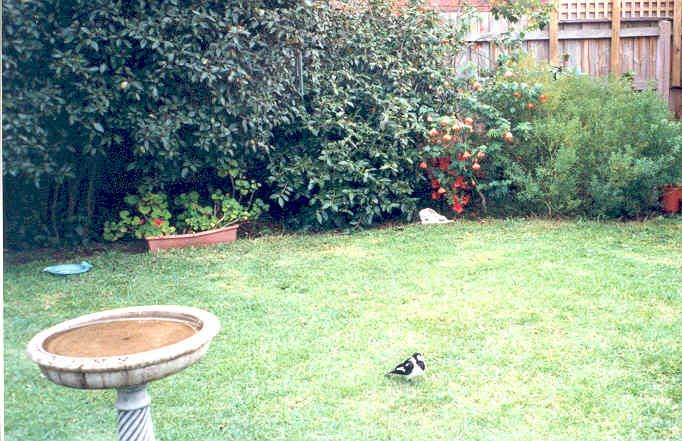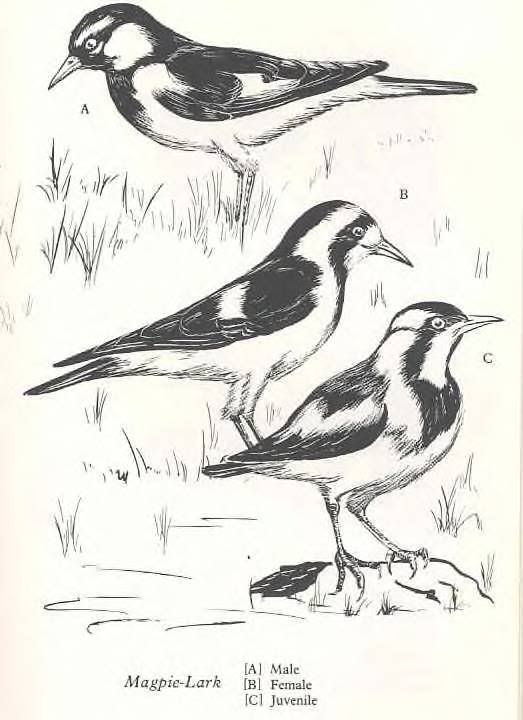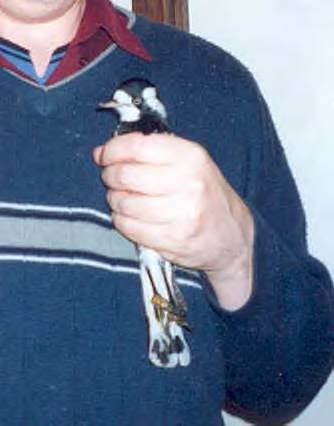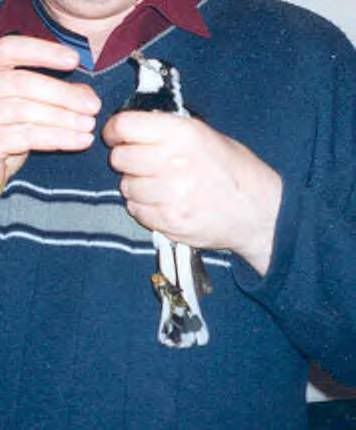If you ever see string, twine, thread on the ground, please pick it up and place it securely wrapped in the rubbish … your taking this action will be removing this pollution, which after all would not be there at all if not for humans, from the environment, and saving some beautiful animal from horrific suffering and tragic premature death. This is Tinky’s life and story …

The Australian Magpie Lark, also known as the Mud Lark or the Peewee, is a beautiful little bird … smaller than the Australian Magpie it is named for, about the size of a blackbird, with obvious black-and-white markings. They spend most of their time on their feet, and you will see them walking back and forth across lawns for hours, picking up insects … they are insectivores, insect-eating birds, and so if you have Magpie Larks in your garden you are lucky, since they will hunt for and eat any insects which might do damage to your plants!
We have had three generations of the one Magpie Lark family in our back garden now … the latest chicks were born and hatched last Spring, and we watched them from afar, before they had left their nest, which was located at the top of a forty-foot pine tree just beyond the creek which borders our backyard … we could see the parents, the nest, and the chicks, from our back verandah, and we enjoyed watching as they spent a few weeks jumping from branch to branch and then returning to their nest, gradually gaining confidence in their bodies and their movements, as all babies do.
As soon as they had grown confident enough to fly, their parents brought them to our back garden, for the food and the safety of their own territory, just as these parents’ own parents before them had brought them to our backyard. It was a delight having the whole family walking around our garden … right from the beginning it was obvious that one of the chicks was bolder and friendlier: often when we were sitting in our garden chairs, she would stride right up to us, and then boldly walk right underneath our chairs looking for any insects who might be hiding underneath. It was enchanting to have the little innocent thing only half-a-foot from us, and so unconcerned!



As had been our experience with other members of her family, some of the chicks would become less attached to the territory, we would see them less and less, and then gradually not at all … although we are certain we have seen these other chicks fully-grown down the street or on the next street-block, having made that their new territory, “leaving the nest”, as with all babies. This little chick, however, decided to make our back garden her territory, and decided that we looked like friendly types worth bonding with! She became friendlier and friendlier, and there were many instances where we would be out in the garden weeding, and as we moved around the edges, she would follow us within an arms’ length and snap up any uncovered insects. She developed her adult plumage, revealing that she was a indeed a little female, but she didn’t show any inclination to leave our, and her, beloved back garden. We began to almost regard her as a little pet, despite recognising that she was of course still a wild creature, so we named her Tinky.
It was so charming to see her hunting insects in our backyard, or hunting and wading in the creek just over the back fence, and sitting in the sun and stretching her feathers out to catch the rays. She even used to greet us at our front verandah when we came home after being out, and once we were very suprised when, while focussing on closing our garage door, we felt something touch our heads … as you can imagine, it was completely unexpected, and as you would, we looked up to see what it was … we were even more pleasantly shocked, surprised and touched, to see Tinky perched on the gutter just above us … it was she who had swooped down and almost landed on our heads … it was as if she was tapping us on the shoulder to say, “hi, I’m here”! She completely melted our hearts one day by appearing beside us one hundred metres down the street and accompanying us, with small flights and walks right beside us, until we got home together. She certainly recognised and liked us, which of course was an absolute honour, to be accepted by a semi-wild animal in that way.
All this changed one day, when she was about six months old, when she appeared in our backyard with a bundle of thin, black thread wrapped around both her legs. She was obviously in awkward discomfort … she could no longer take her normal gaited steps, but was forced to hobble and hop, was now terribly unsteady on her feet, often overbalancing and almost falling over, and could not even reach her feet up to her wings and head to groom as she had always done before. It broke our hearts to see her suffering like this, and we many times tried to capture her over the next few weeks. But her suffering from being horribly incapacitated was also making her so sad, angry, depressed and standoffish, and she would now only allow us to get to about three metres from her before she would fly away, whereas before she used to move to within a foot of us. We spoke to several Wildlife Carers for help and advice, including the legendary Ninon, and Yvonne, known as “the Possum Lady”, who gave us the invaluable advice on how to remove the thread should we finally capture Tinky, by running a needle underneath the thread if it was very tight about the little bird’s legs.
We could also see that Tinky was losing weight, obviously because she could no longer hunt insects as successfully - she could barely walk, which must be torture for a Magpie Lark, who by their nature spend so much time on their feet and walking. So we began to feed her mincemeat, suggested by a couple of Wildlife Carers, throwing it to her and watching her gobble it down. Nevertheless, she continued to lose weight, and we could see that she was becoming more depressed, often just sitting on her stomach in the one place for hours. Once we saw her sitting like this in the middle of our lawn, and she actually closed her eyes and tucked her head under her wing … a very worrying and dangerous thing for any bird to do during the day, and something a bird will never do unless it is feeling really bad, because it is an immediate target for predators. Well, it was just lucky that she did this in our backyard, because we ran for the net (which Yvonne had suggested we buy from a fishing and bait shop) and - after weeks and weeks of trying unsuccessfully, we had finally caught her! Now we could help her!



On close inspection, her poor feet were a terrible mess. The thread was tight around both her ankles, and several of her toes were broken and limp. Her feet had also formed massive lumps of scar tissue which in some places enveloped the thread, and we were loathe to touch this scar tissue for fear of damaging her healing. Having kept canaries for decades, we are aware that if a bird’s toes are badly broken, they will eventually lose all blood flow and fall off, but we were also aware that this takes time and is terribly incapacitating for the little bird. All in all, it took us two and a half hours to remove all the thread from her feet and toes, with one person holding her and the other person running the needle underneath the tight thread, being careful not to stick the needle into her skin (though the scar tissue bled), and then running surgical scissors (which we bought from a chemist shop) along the needle in order to get the scissors under the thread and finally cut it. A torch helped us see the dark thread against her dark skin. We had to take numerous breaks, but we later calculated the two and one half hours of working on her not including the breaks. It was lucky that she knew us, knew our voices which seemed to soothe her … she didn’t seem too stressed by our handling her … we don’t think a truly wild animal could handle this treatment as well as she did. If anything, she actually seemed to realise what we were doing, and she was definitely relieved to have the thread gone … she could actually move her legs again! Could groom, could walk in her normal gait!


But she was not back to normal at all. Although we removed the thread, she had been injured and remained tragically debilitated. Apart from her missing toes, the remaining broken toes were limp, and when we released her, we could see as soon as she began to walk around that she remained lame, and many times she would look down at her feet and peck at them. She could groom now, although with difficulty, because of her missing and broken toes. And she did not seem to be gaining weight, either. We would see her parents down by the creek, walking along the waterline and catching juicy insects … whenever Tinky tried to do this, she was awkward and slow with lameness.

We were very relieved that she remained in our back garden, because we continued to feed her mincemeat. She really looked as if she enjoyed sitting in the warmth of the sun on sunny days, and she appeared to enjoy our company as much as we enjoyed hers. But winter was drawing near, and she really seemed to suffer on rainy and windy days, and she would sit underneath our Australian tree ferns. She still looked underweight, and often fluffed up, which is a bad sign that indicates a bird who is trying unsuccessfully to keep warm, as we knew from experience with canaries. One day, three weeks after we had removed the thread from Tinky’s feet, we came home at eleven o’clock at night on a windy, cold night, to find her sitting underneath our tree ferns, fluffed up and apparently sleeping there. We caught her easily, too easily, and brought her inside, and put her into one of our canary hospital cages, with a lamp on her for warmth. We kept her in the hospital cage for a few days, keeping her constantly warm with the lamp, and fed her mincemeat and mealworms (from the pet shop) every couple of hours, and both plain and sugared water (a tip from the Wildlife Carer, Saria). Sometimes she seemed to pick up for a few hours here and there, despite being so terribly underweight that her breast bone protruded shockingly sharply, and she had a laboured, wheezing, breathing which did not disappear. Nevertheless, often, when we approached the cage, she would brightly jump up on to the edge of the water jar we had placed with her, in order to get closer to us and gaze into our eyes - incredibly touching behaviour from a wild creature.
But her constant wheeze continued, and did not improve despite the nursing and heat which we constantly gave her. After a few days of this intensive nursing, we got up in the morning to find that instead of standing, she was sitting on her stomach with her eyes closed, and wheezing again. We cupped her against our bodies for warmth, tried to feed her water with a syringe, but after an hour of just holding her and keeping her warm, she died. She did die warm, dry, and safe, we did help her, but it was not her time to die at all. Tinky was a very special, precious individual, as all living creatures of course are, and we will never forget her. And she would be living a healthy life right now, as all animals deserve to, if not for the pollution of that knotted piece of thread, which caused her so much suffering and misery, as well as caused her death before she was even one year old.
Please, if you ever see string, twine, thread on the ground, pick it up and place it securely wrapped in the rubbish … your taking this action will be removing this pollution, which after all would not be there at all if not for humans, from the environment, and saving some beautiful animal from horrific suffering and tragic premature death.

